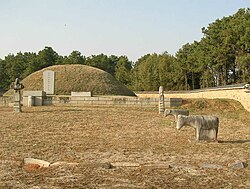Sangju
|
Sangju 상주시 |
||
|---|---|---|
| Municipal City | ||
| Korean transcription(s) | ||
| • Hangul | ||
| • Hanja | ||
| • Revised Romanization | Sangju-si | |
| • McCune-Reischauer | Sangju-si | |
 |
||
|
||
 Location in South Korea |
||
| Country |
|
|
| Region | Yeongnam | |
| Administrative divisions | 1 eup, 17 myeon, 6 dong | |
| Area | ||
| • Total | 1,254.82 km2 (484.49 sq mi) | |
| Population (April 1, 2012) | ||
| • Total | 105,370 | |
| • Density | 84/km2 (220/sq mi) | |
| • Dialect | Gyeongsang | |
| Flower | Rose | |
| Tree | Diospyros kaki | |
| Bird | Eurasian magpie | |
Coordinates: 36°26′N 128°10′E / 36.44°N 128.17°E
Sangju is a city in North Gyeongsang Province, South Korea. Although Sangju is rather rural, it is very old and was once a key city. Along with Gyeongju, it gives rise to half of the name of the Gyeongsang provinces. Sangju is nicknamed Sam Baek, or "Three Whites", referring to three prominent agricultural products rice, silkworm cocoons, and dried persimmons from the area.
Sangju lies on the northwestern border of North Gyeongsang province, touching on North Chungcheong province. Thus, to its west and north it adjoins the North Chungcheong counties of Boeun, Goesan, Okcheon, and Yeongdong. Within North Gyeongsang province, it touches Mungyeong on the north, Yecheon, Uiseong, and Gumi on the east, and Gimcheon to the south.
...
Wikipedia

